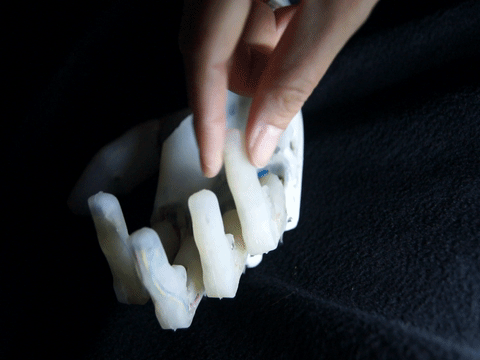KYUNG
YUN
CHOI

A Low-Cost, Open-Source, Compliant Hand
for Enabling Sensorimotor Control
for People with Transradial Amputations
Even though lots of state-of-the-art prosthetic devices have been developed, still it becomes pressure for amputations living in low-income countries to access those devices which cost between $30,000~ $40,000. According to the World Health Organization, 80% of people with amputations live in developing nations, while only 1 to 3 % of these people have access to appropriate rehabilitation services.
In order to contribute to a more equitable distribution of prosthetic care, I have been working on developing a low-cost robotic prosthetic hand in Bretl Research Group. The main goal of this project is providing a highly functional and low-cost prosthetic hand for people with below-elbow amputations primary focused in developing nations where access to affordable prosthetic care has been limited. We use non-invasive electromyography (EMG) with pattern recognition to enable motor control. Also, we use sensory feedback via electrotactile stimulation and contact reflexes to restore a sense of proprioception and touch.
The current design of the hand is high impact resistant and strong; individual finger can hold up to 17.5 kg. Also, by designing the compliant composite structure and fabrication methods, I enabled the hand to be lightweight (340 g) and small (50 percentile female. The development cost of this hand is $ 550. All of the bills of materials and sour-codes are open-sourced. [Link]


Award
-
A'DESIGN AWARD, Bronze award in Cybernetics, Prosthesis and Bio-Engineering Design, Italy [Link]
-
3D Printing Contest, Judges Prize in Health, Instructables, United States [Link]
-
2016 Research Live!, Finalist, Graduate College, University of Illinois at Urbana-Champaign [Video] [News]
Paper
-
K. Y. Choi, A. Akhtar, T. Bretl, "A compliant four-bar linkage mechanism that makes the fingers of a prosthetic hand more impact resistant", in IEEE International Conference on Robotics and Automation, Singapore May. 2017.
-
A. Akhtar, K. Y. Choi, M. Fatina, J. Cornman, E. Wu, J. Sombeck, C. Yim, P. Slade, J. Lee, J. Moore, D. Gonzales, A. Wu, G. Anderson, D. Rotter, C. Shin, and T. Bretl, “A low-cost, open-source, compliant hand for enabling sensorimotor control for people with transradial amputations,” in International Conference of the IEEE Engineering in Medicine and Biology Society (EMBC), Orlando, FL, Aug. 2016. [pdf]
Open-source
-
How to build? manuals, CAD files can be found in Instructables site [Link]
Media Appearance
-
College of Engineering: Podcast
-
Department of Aerospace Engineering [Link]
-
THE DAILY ILLNI: [Link]
The Range of Motion Project
This video shows the impact of sensory feedback system through electrotactile stimulation and contact reflexes. The subject did grasping a hollow eggshell and plastic water cup task both with visual and without visual feedback. The subject was able to grasp delicate objects while he could not when he was using a commercial non-sensory feedback prosthetic hand (Otto buck)

With the non-profit organization Range of Motion Project (ROMP), we apply our technology to meet the needs of people with upper-limb amputations in Ecuador. ROMP has provided over 1,000 prosthetic devices to patients throughout the Americas. It maintains a locally-staffed, fully-operational prosthetic clinic in Quito.
March, 2016, we went to Quito, Ecuador for this project. The purpose of this trip was to test a sensory feedback system for upper limb prosthetic devices and compatibility of new mechanism, and more importantly the adaptability of the hand by local people. We wanted to evaluate its effectiveness when being used in typical applications by an actual amputee, and keep trying to follow them to see how the device affect the life of amputees.
From March 18th to 26th, we built an another hand for Juan Suquillo, the patients with left upper limb amputations, affiliated with ROMP in Quito. During the 7 days, I was able to print parts for the left hand with 3-D printer that ROMP had and integrate all parts.
This international-collaboration project was a so grateful opportunity for us in the area of prosthetic care volunteering with ROMP. By doing experiments not only in the lab environment but also applied to the real world problem, we could see the prosthetic device we built from different perspective finding what the end-users really need and what we should improve.



3-D printing a bone structure using compliant material (SemiFlex- Polyurethane)

Fixing two MEMS barometric pressure sensors on fingertip and harnessing the wires


Fixing the bone on the 3-D printed molds

Molding silicone in the molds to encapsulate the bone in human-skin like skin (DragonSkin-20)

After 4 hours of silicone cure, pull out the finger and assemble linkage
Fabrication Process

Prosthetics Group in Bretl Research Group

